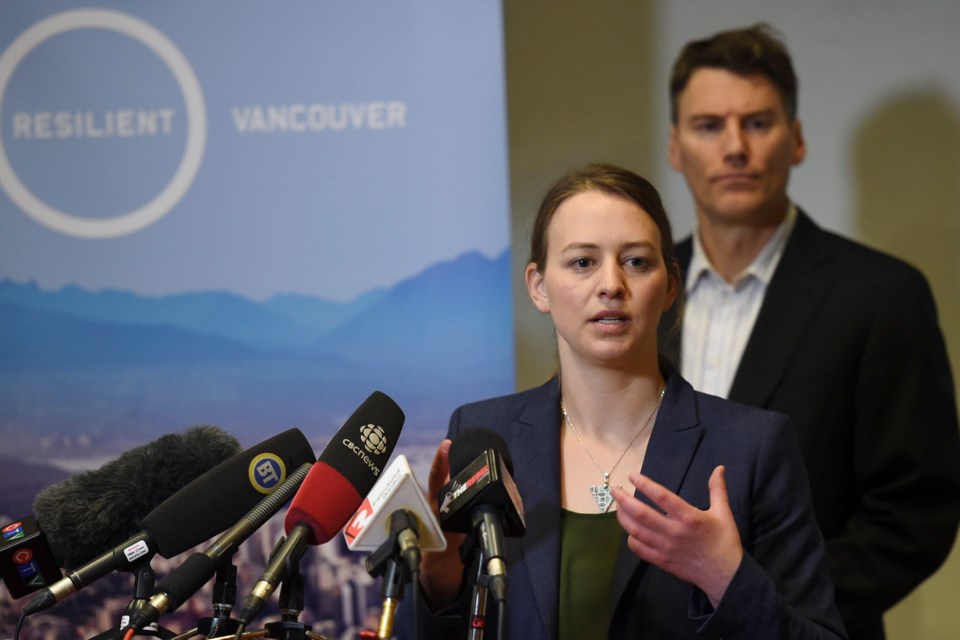News item: Mayor Gregor Robertson announces appointment of chief resilience officer, Katie McPherson. He says McPherson will develop a citywide resilience strategy to “ensure our residents, communities, institutions, businesses and systems can persist, adapt and grow no matter what kinds of chronic stresses and acute shocks Vancouver may experience.”
Now read that again.
Once your brain cramp subsides, please explain to me what exactly you think McPherson will be doing in her two-year gig paid by the Rockefeller Foundation.
I know, I know, I’m supposed to figure that out.
The mayor has told us it has something to do with “resilience,” which is that new unfortunate go-to buzzword making the rounds these days in bureaucracies. (So sorry to see you go, “sustainability.” Good luck with the severance package.)
I tried, I really tried to understand the need for such a position — or what it is — when I and others posed questions Tuesday at a news conference to announce McPherson’s appointment. The mayor was there, so was McPherson and a guy named Jeb Brugmann, director of solution development and innovation for an organization called 100 Resilient Cities, which is tied to the Rockefeller Foundation.
According to the group’s website, it is “dedicated to helping cities around the world become more resilient to the physical, social and economic challenges that are a growing part of the 21st century.”
It further supports “the adoption and incorporation of a view of resilience that includes not just the shocks — earthquakes, fires, floods, etc. — but also the stresses that weaken the fabric of a city on a day-to-day or cyclical basis.” In Vancouver’s case, as I heard, that’s homelessness, housing affordability and the drug overdose crisis.
So how the heck do you tie homelessness to an earthquake?
I didn’t get an answer that I fully understood, although it has something to do with if the Big One hits and people are on the street or living on the margins, then they won’t recover as well. So address those vulnerabilities to lessen the social damage after a disaster.
Those last two sentences were brought to you by Captain Obvious.
I also heard how some cities and governments tend “to work in silos” instead of collaborating on an overall strategy that ties, for example, the city’s housing and homelessness plan with the city’s healthy city plan. I’m sure the city already does that, and I’d bet city manager Sadhu Johnston would argue his departments do not work in silos; working together with senior levels of government, well that’s a different story — and not exactly breaking news, said all the mayors, past and present, of Vancouver.
The need for a chief resilience officer suggests Vancouver’s emergency management planning isn’t up to speed on how the city will handle an earthquake or similar disaster when it comes to responding to residents — young and old, rich and poor.
Again, the city has worked on preparing for such an emergency for decades. Of course, cities can always learn from each other — whether it be what New York City learned after Hurricane Sandy or Calgary learned after its floods — but if Vancouver isn’t already on top of these “best practices,” then taxpayers should be outraged.
You should know that McPherson, who earned $109,281 in 2015, already works for the city. And, as I learned via Google, she was the “manager of community resilience” for the city’s office of emergency management when she attended the Canadian Science Policy Conference in November 2016 in Ottawa.
That same bio said McPherson’s role was to manage “all aspects of volunteer, community and business engagement programs, conducting risk and hazard assessments and facilitating multi-agency teams in the development and implementation of mitigation and response plans for all hazards.”
That was in November 2016.
So I asked her to explain her new gig and how it differs from her old gig.
This was her response.
“A big part of what my role will be is leading the development of a resilient strategy for the city. We already have a very strong foundation towards resilience. Our healthy city strategy, our greenest city action plan, renewable city strategy — a number of these form a basis for resilience. So what we hope to do — what we intend to do — through the resilience strategy is to really look holistically at all of these, assess where the gaps may be and leverage the resources and skills that will come from 100 Resilient Cities to address those gaps and to help to fast-track actions we may have already identified. Another big piece of this is stakeholder engagement…”
OK, I’m going to end the quote there because I have almost reached my quota for quoting and spelling the word “resilient” in one column. I’m going to leave you with a further ambiguous quote. This one is from the mayor, which I think is about the importance of a partnership with 100 Resilient Cities -- which includes Calgary, Toronto and Montreal -- and the need for a chief resilience officer.
“It’s about really ensuring that there are no gaps, that our lowest common denominator is raised up and we don’t suffer from weaknesses that are exposed under great stress.”
Please don’t get me to explain what that means.
Ask someone smarter, more resilient to breaking down mind-bending jargon.
mhowell@vancourier.com
@Howellings



